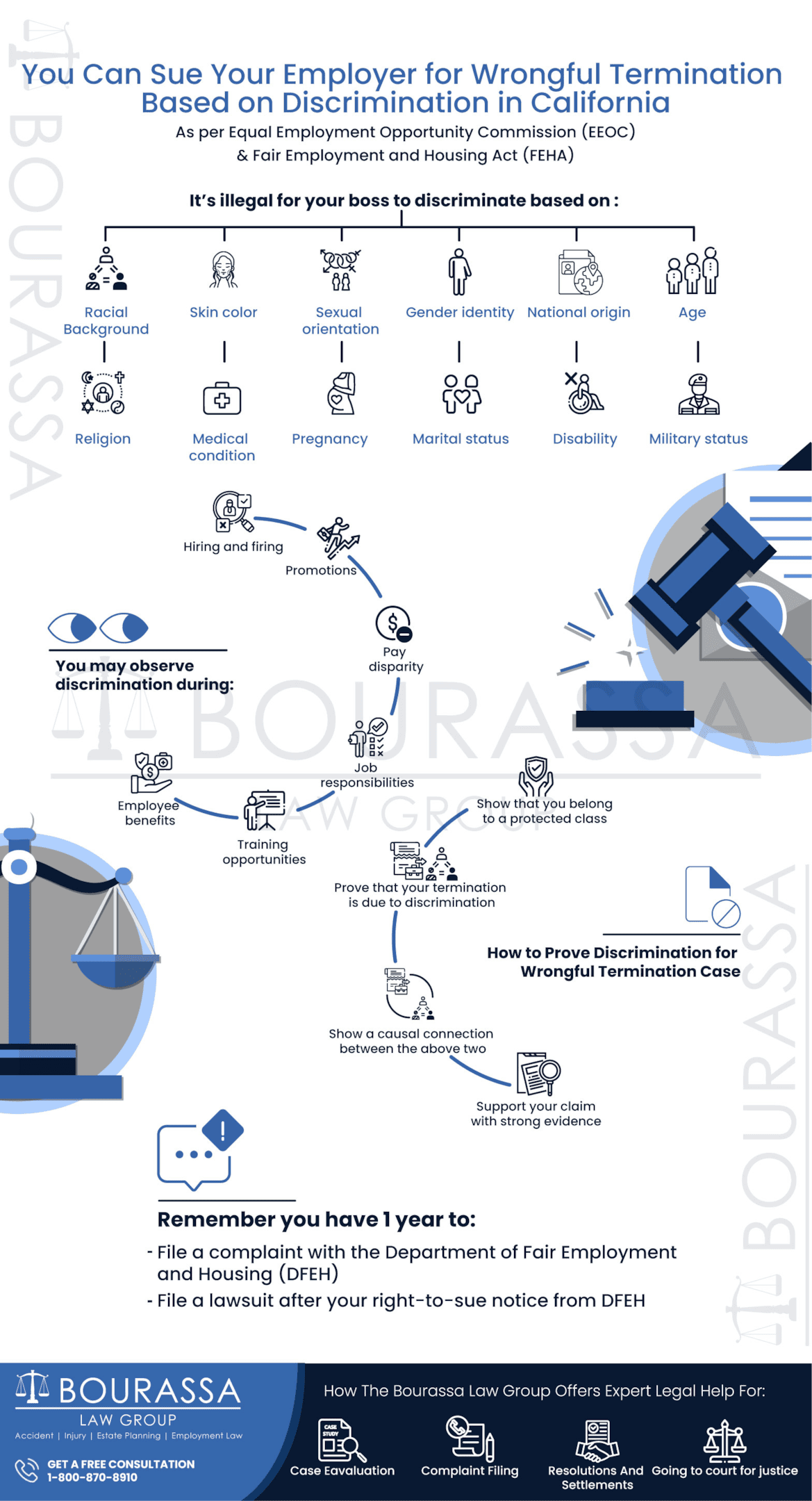
In today’s changing employment landscape, sudden termination of employment are the most hurtful–especially you think your termination was due to discriminatory conduct. The financial and psychological implications are long-lasting even when California’s at-will employment law allows such cases. However, under certain circumstances, at will employees can sue an employer if they were wrongfully terminated, including based on discrimination. This article discusses wrongful termination for discrimination and what legal options an employee can pursue.

Is Discrimination and Wrongful Termination the Same Thing?
Although discrimination is critical in many wrongful termination cases, the two terms are not interchangeable. Discrimination may or may not include a wrongful discharge from employment.
Irrespective of whether it involves discrimination, retaliation, illegal practices, a breach of an employment agreement, or other illegal grounds, you may have a claim if your termination was unlawful, however.
In order to show that your termination was unlawful under California law, you must show discriminatory conduct leading to your wrongful termination or breach of a written employment contract or implied contract or a public policy violation.

Federal and State Anti-Discrimination Laws
Over the years, workplace discrimination charges filed in California decreased due to robust guidelines. However, discrimination still occurs far to frequently, as The U.S. Equal Employment Opportunity Commission (EEOC) has reported. The EEOC is the federal government agency entrusted with administering federal laws against employment discrimination. Federal legislation like the Age Discrimination in Employment Act (ADEA), the Americans with Disabilities Act (ADA), and Title VII of the Civil Rights Act of 1964 fall under EEOC.
However, California goes above and beyond federal employment laws by passing its own anti-discrimination laws. In addition to federal laws against discrimination, the California labor code safeguards employees from wrongful termination due to discrimination. The most notable is the Fair Employment and Housing Act (FEHA). Compared to federal law, state laws provide broader protections and covers more protected categories than Federal Civil Rights Act .
Employers must refrain from mistreating workers under the FEHA and federal laws. An employer may not fire employees is based on race, color, national origin, sex, religion, handicap, age, genetic information, disability, marital status, or sexual orientation.
Therefore, it may be considered a wrongful termination if an employer dismisses an employee due to these characteristics.

Understanding Employment Discrimination as per the EEOC and FEHA
Discrimination, as defined by the Equal Employment Opportunity Commission (EEOC) and under California labor law, is the act of treating an employee unfairly or prejudicially because of specific protected characteristics. These protected traits encompass a wide range of attributes and identities, and it is crucial to understand and address discrimination associated with them. Here’s a detailed exploration of these protected characteristics:
Race:
Discrimination based on an individual’s racial background, ethnicity, or any physical attributes associated with their race is considered unlawful. This includes instances where someone is mistreated solely because of their racial identity or heritage, whether it be their skin color, facial features, or cultural background.
Color:
Unjust treatment that stems from an individual’s skin color or complexion is another form of discrimination. This means that individuals should not be subjected to bias or unequal opportunities based on the shade of their skin.
Religion:
Discrimination in the workplace related to a person’s religious beliefs, practices, or affiliation is prohibited. Employees should not face adversity or bias due to their faith or spirituality, regardless of what religion they follow or if they practice no religion at all.
Sex (including pregnancy, gender identity, and sexual orientation):
Discrimination tied to an individual’s sex is a broad category. It encompasses gender-based discrimination, but it also extends to discrimination and sexual harassment as well as discrimination against pregnant employees. Moreover, it includes bias related to gender identity and sexual orientation. This means that employees should be treated fairly regardless of their gender, pregnancy status, gender identity, or sexual orientation.
National origin:
It is against the law to treat someone differently based on their country of origin, ancestry, or accent. Discrimination based on where a person or their ancestors come from is not permissible in the workplace.
Age (40 or older):
The Age Discrimination in Employment Act (ADEA) protects individuals aged 40 or older from discrimination. This means that older employees should not be subjected to unfavorable treatment based on their age. Their experience and qualifications should be valued and respected.
Disability:
The Americans with Disabilities Act (ADA) safeguards individuals with disabilities from discrimination, whether they have physical or mental impairments. This protection extends to both permanent disabilities and some temporary conditions, ensuring that employees are not treated unfairly due to their disability status.
In addition to the EEOC, the Fair Employment and Housing Act (FEHA) offers further protection to employees with the following additional protected characteristics:
Medical Condition:
Discrimination based on an individual’s medical condition, illness, or disability is covered by FEHA. This includes any unfair treatment disability discrimination stemming from physical or mental health conditions, regardless of whether they are temporary or permanent in nature.
Marital Status:
Marital status discrimination refers to treating individuals differently based on their relationship status. It encompasses whether a person is single, married, divorced, separated, or in a domestic partnership. Employees should not face bias because of their personal choices in this regard.
Military or Veteran Status:
FEHA prohibits differentiation based on an individual’s military service or veteran status. This encompasses discrimination against current or former members of the armed forces, including reserves and National Guard, as well as veterans of a military branch. Service to one’s country should not result in unfair treatment in the workplace.
Common Occurrences of Employment Discrimination
Discrimination in the workplace can manifest in various forms and stages of employment, affecting hiring decisions, day-to-day work experiences, and career advancement. Here are some common instances of workplace discrimination based on protected characteristics:
Hiring Decisions: This occurs when an employer unfairly favors or disqualifies a candidate during the hiring process based on their protected characteristic. For instance, rejecting a qualified applicant due to their race, gender, religion, or another protected trait constitutes discriminatory hiring practices.
Firing Decisions: Wrongful termination based on a protected characteristic is a fundamental concern in employment discrimination cases. If an employee is fired due to their age, disability, sex, or another protected characteristic rather than their job performance, it constitutes illegal discrimination. Wrongful constructive termination can also occur where an employee feels that he or she has no option but to resign due to unlawful actions of the employer.
Promotions and Advancements: Discrimination can also take the form of unequal opportunities for career progression or promotion. If employees are denied promotions or advancement solely because of their protected characteristics, it hinders their professional growth and is a violation of anti-discrimination laws.
Pay Disparities: Pay disparities occur when employees with the same qualifications and job responsibilities are paid differently based on their protected characteristics. Gender pay gaps, for example, can result from discriminatory practices.
Job Assignments: Discriminatory practices may involve assigning tasks or responsibilities unfairly based on an employee’s protected characteristics. For instance, giving undesirable or less prestigious assignments to employees due to their race or age constitutes discrimination.
Layoffs and Downsizing: Discrimination can rear its head during layoffs or downsizing when employers select employees for termination based on protected characteristics rather than objective criteria, such as seniority or performance. This can lead to unjust layoffs and is unlawful.
Training and Development: Excluding individuals from training and development opportunities based on their protected characteristics is another form of discrimination. When employees are denied access to career-enhancing training programs due to their race, gender, or disability, it hampers their professional growth.
Benefits and Perks: Denying certain benefits, privileges, or perks to employees because of their protected characteristics is discriminatory. This includes unequal access to healthcare benefits, retirement plans, or company perks like flexible work arrangements.

Can I Sue My Employer for Wrongful Termination?
Employees who feel they were wrongfully terminated or wrongfully frequently ask, “Can I sue my employer for wrongful termination?” However, the answer requires an in-depth assessment of different factors.
How Do You Prove Discrimination in the Workplace?
As the plaintiff, you must present several vital elements to succeed in a wrongful termination lawsuit based on discrimination:
Protected Characteristic:
You must show that you belong to a protected class under anti-discrimination laws. It includes discrimination due to your age, race, gender, disability, or other protected class or characteristic.
Adverse Employment Action:
You must prove that your employment termination or other adverse employment actions are due to discrimination. It includes demotion, reduction in pay, or a hostile work environment.
Causation:
There must be a causal connection between your protected characteristic and the adverse employment action. Hence, you must show that you were terminated for your protected characteristic, not legitimate business reasons.
Evidence:
Strong evidence is crucial to support your claim. It may include documents, emails, witness statements, or other proof establishing discrimination as your termination’s cause.
Burden of Proof
In wrongful termination cases based on discrimination, the burden of proof often shifts between the parties involved. Initially, as the plaintiff, you must present a prima facie case by showing the elements mentioned above.
However, the burden shifts to your employer once you meet this burden.
They must provide a legitimate, non-discriminatory reason for your termination. If the employer does so, you must demonstrate that their reason is a pretext for discrimination.

Remedies Available
In cases of workplace discrimination, employees who have suffered unjust treatment have legal recourse to seek redress for the harm they’ve endured. These remedies are designed to not only compensate the victim but also to discourage employers from engaging in discriminatory practices in the future. Here are some common legal remedies available to individuals who have experienced workplace discrimination:
Reinstatement:
If a court determines that you were wrongfully terminated due to discrimination, it may order your employer to reinstate you to your former position or a similar one within the organization. Reinstatement is a remedy aimed at restoring you to the position you held before the discrimination occurred, ensuring that you regain your job and associated benefits.
Back Pay:
Back pay is a form of compensation for lost wages and benefits that you would have earned if not for the discriminatory actions of your employer. This typically covers the period from your termination to the present. It aims to make you financially whole by reimbursing you for the income and benefits you lost due to the discrimination.
Front Pay:
In certain situations where reinstatement is not feasible or appropriate, the court may award front pay. Front pay represents compensation for future lost wages and benefits that you are expected to suffer as a result of the discrimination. It ensures that you are financially supported until you secure comparable employment.
Compensatory and Punitive Damages:
In cases of intentional discrimination, you may be entitled to compensatory damages to compensate for emotional distress, pain, and suffering caused by the discriminatory actions. Additionally, punitive damages may be awarded as a deterrent to your employer and to punish them for particularly egregious discriminatory behavior. Compensatory and punitive damages go beyond economic losses and seek to address the emotional toll of discrimination.
Attorney’s Fees and Costs:
If you prevail in your discrimination case, the court may order your employer to cover your attorney’s fees and legal costs. This provision ensures that employees who face discrimination are not deterred from pursuing legal action due to the financial burden of legal representation. It also serves as a safeguard against frivolous discrimination claims.
Statute of Limitations
You must know the statute of limitations for filing a wrongful termination lawsuit based on discrimination in California. Under FEHA, you have one year from the date of the alleged discrimination to file a complaint with the California Department of Fair Employment and Housing (DFEH).
After receiving a right-to-sue notice from the DFEH after the employer fires, you have one year to file a wrongful discharge lawsuit in court.

What Do You Do if You Are Fired Unfairly?
If you believe you have a potential employment law claim wrongful termination case is due to discrimination, seek legal help and file a lawsuit. Here are some necessary steps you must know to pursue this option:
Consult with an Employment Attorney:
Consult an experienced employment attorney to pursue a wrongful termination claim. Employment law is complex and can vary depending on jurisdiction. An attorney can provide insights, assess case merits, and guide the legal process.
Moreover, they listen to your story, review evidence, determine a valid claim, and explain your rights and potential remedies.
Gather Evidence:
Gather all relevant evidence to establish a strong case for wrongful termination based on discrimination. That includes employment contracts, performance evaluations, disciplinary records, emails, and correspondence with the employer.
Moreover, interview colleagues and create a detailed timeline of events leading to and following the termination. Retain any records of discriminatory behavior, like offensive comments, policies, or unequal treatment, if possible, to support your claims.
File a Complaint:
You must file a complaint with the California Department of Fair Employment and Housing (DFEH) or the EEOC. The organization will issue a notice allowing you to file a lawsuit.
Furthermore, your attorney will assist you in preparing and filing this complaint. They can ensure it adheres to all legal requirements and deadlines.
Attempt Resolution:
Many employers prefer to resolve wrongful termination claims through negotiation or settlement before heading to court. Employment lawyers can help in reaching a satisfactory resolution on your behalf.
It involves discussions with your employer or their legal representatives to secure compensation, reinstatement, or other remedies.
File a Lawsuit:
If negotiations fail to yield a resolution, your attorney may advise you to proceed with a lawsuit against your employer. This legal action will involve presenting your case before a court.
If your case proceeds to trial, a judge or jury will decide based on the evidence presented.

Get Expert Legal Help from Top-Tier Employment Lawyers at BLG
Wrongful termination based on discrimination can be emotionally and financially distressing. If you believe you faced a wrongful termination for discrimination or other unlawful reasons, seek legal counsel.
At BLG, our team of top-rated employment lawyers in California has a proven track record of helping employees navigate their wrongful termination cases. We are committed to upholding your rights and fighting for the justice you deserve.
Your legal rights do matter, and we are here to protect them. Let our experienced employment attorneys assess your case and guide you.
Contact us today to your legal rights and schedule a free consultation.
The Bourassa Law Group
9440 Santa Monica Blvd #301
Beverly Hills CA 90210





